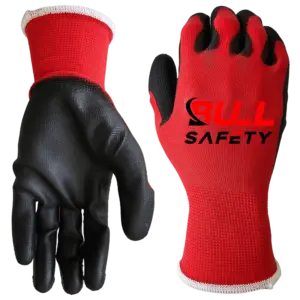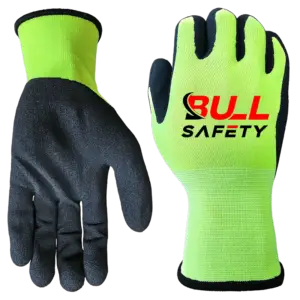
bullsafety 13g red PU palm coated gloves
Choosing between PU and nitrile gloves can be challenging, as both materials offer unique advantages. Understanding their differences is key to selecting the right gloves for your needs.
PU gloves excel in precision and flexibility1, while nitrile gloves are better for chemical resistance and durability. The choice depends on the specific task and environment.
Whether you’re selecting gloves for industrial work, medical use, or general protection, it’s essential to know how PU and nitrile coatings compare2. Let’s explore their features in detail.
Is nitrile coated better than PU coated?
Both nitrile and PU coatings have their strengths, but which one is better depends on the application and the environment.
Nitrile coatings are better for durability and chemical resistance, while PU coatings are superior for precision work and breathability.

bullsafety 13g yellow polyester liner black sandy nitrile palm coated gloves
The decision between nitrile and PU coatings largely depends on the intended use. Here’s a breakdown:
- Nitrile Coating: Known for its toughness and chemical resistance, nitrile-coated gloves are ideal for handling oils, chemicals, and abrasive materials. They are often used in heavy-duty industrial work and environments where durability is crucial.
- PU Coating: PU coatings are lighter, thinner, and more flexible. These gloves provide excellent grip and dexterity, making them perfect for precision tasks like assembly or electronics work. However, they may not perform as well in environments with heavy chemicals or abrasive surfaces.
Comparison Table: Nitrile vs. PU Coatings
| Feature | Nitrile Coating | PU Coating |
|---|---|---|
| Chemical Resistance | High | Low |
| Abrasion Resistance | Very High | Moderate |
| Flexibility | Moderate | High |
| Grip in Wet Conditions | Excellent | Good |
| Ideal Use Case | Heavy-duty tasks | Precision tasks |
Are PU coated gloves heat resistant?
Heat resistance is a critical factor for many industries. Can PU-coated gloves provide adequate protection against heat?
PU-coated gloves are not heat resistant. They are designed for dexterity and grip but are unsuitable for high-temperature applications.
PU coatings are primarily used for their flexibility, lightweight design, and excellent grip. However, they are not intended for heat resistance. The polyurethane material can degrade or melt when exposed to high temperatures, making them unsuitable for tasks involving open flames or hot surfaces.
For heat-resistant applications, gloves with coatings such as nitrile, Kevlar, or silicone are better suited. These materials are specifically designed to withstand higher temperatures without compromising safety.
Recommended Coatings for Heat Resistance
| Coating Type | Heat Resistance Level | Ideal Applications |
|---|---|---|
| Nitrile Coating | Moderate | Handling hot objects briefly |
| Silicone Coating | High | High-heat industrial work |
| Kevlar Coating | Very High | Welding, foundry work |
| PU Coating | Low | Precision tasks, non-heat work |
What should you not use nitrile gloves for?
While nitrile gloves are versatile, there are specific scenarios where they are not the best choice.
Nitrile gloves should not be used for handling strong solvents, ketones, or high-heat applications, as these can degrade the material or reduce its effectiveness.
Nitrile gloves are excellent for chemical resistance, but they do have limitations. Here are key situations where nitrile gloves might fall short:
- Strong Solvents: Chemicals like acetone or certain ketones can break down nitrile material, making it less effective for protection.
- High Temperatures: Nitrile gloves are not designed to withstand extreme heat and can melt or lose their protective properties when exposed to high temperatures.
- Tactile Sensitivity: For tasks requiring extreme precision, thinner materials like PU-coated gloves may provide better tactile feedback.
It’s important to choose the right glove type for the specific risks and requirements of the job.
Alternatives to Nitrile Gloves
| Task Type | Recommended Glove Material |
|---|---|
| Handling Strong Solvents | Butyl or PVA gloves |
| High-Heat Work | Kevlar or silicone-coated gloves |
| Precision Work | PU-coated gloves |
What two coatings are most common for cut gloves?
Cut resistant gloves are vital in many industries, and their effectiveness depends heavily on the type of coating.
The two most common coatings for cut-resistant gloves are PU and nitrile. Each offers unique advantages based on the work environment.
Cut-resistant gloves are designed to protect workers from sharp objects and abrasions. The coating plays a significant role in enhancing the glove’s performance:
- PU Coating: Offers excellent grip and dexterity, making it ideal for precision work in industries like electronics or automotive assembly.
- Nitrile Coating: Provides superior durability and chemical resistance, making it a better choice for tasks involving oils, sharp materials, or heavy-duty work.
These coatings, when combined with cut-resistant liners like HPPE or Kevlar, ensure optimal protection and functionality.
Comparison Table: PU vs. Nitrile Coatings for Cut Gloves
| Feature | PU Coating | Nitrile Coating |
|---|---|---|
| Grip on Dry Surfaces | Excellent | Very Good |
| Grip on Oily Surfaces | Moderate | Excellent |
| Cut Resistance Level | High with proper liner | Very High with proper liner |
| Common Uses | Light assembly, precision tasks | Heavy-duty, oil handling |
Conclusion
PU and nitrile gloves cater to different needs, with PU excelling in flexibility and precision, while nitrile offers superior durability and chemical resistance3. Understanding their strengths and limitations ensures the right choice for any application.



